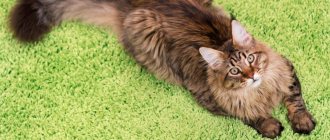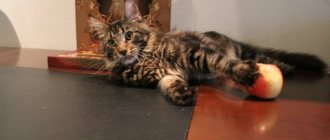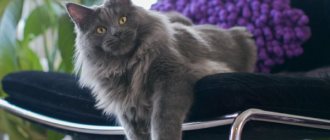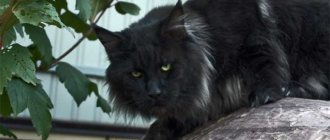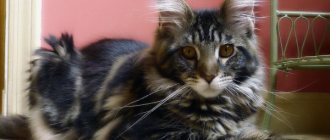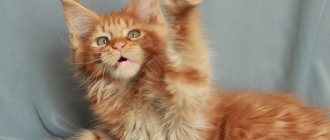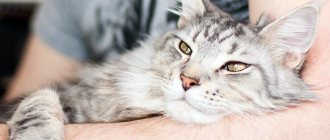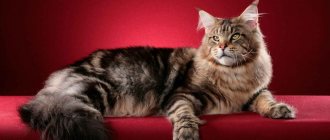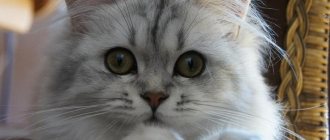To find out for sure whether your kitten is a representative of the Maine Coon breed, to assess its prospects as a sire and to predict the chances of receiving regalia and titles at exhibitions, you need to know the breed standards.
There are different associations of cat lovers and breeders, each of them develops its own judging rules for a particular breed. These standards are basically similar to each other, but still have differences.
For the Maine Coon breed, the most current standards at the moment were created by the WCF (World Cats Federation), FIFe (Federation International) and TICA (The International Cat Association) systems. Despite a lot of nuances, they all paint the same image of a “correct” Maine Coon cat. A detailed study of the standards helps to clearly imagine the appearance of a thoroughbred “coon”.
Body
The Maine Coon is the largest of the domestic cats. The average weight of an adult Maine Coon is 6-8 kg. Cats reach 9-10 kg; exceeding this parameter, as a rule, indicates that the handsome furry cat is obese. The body length of an adult is up to 135 cm, the height at the withers is from 25 to 45 cm, which is comparable to a fairly large dog. Cats are smaller than cats and more gracefully built. See also photos of an adult Maine Coon.
The build is dense, moderately stocky. The body is elongated horizontally, the silhouette has a rectangular outline. This breed has heavy bones and well-developed, trained muscles. Thanks to excellent muscle tone, the body radiates a feeling of strength and power.
The neck is solid, of medium length, looking like a strong pillar. As a rule, the neck is framed by a magnificent thick collar. The sternum is wide and powerful. The paws are strong, strong, proportional to the body. The feet are large, rounded, and bushy hair grows between the toes.
The tail is longer than average, normally reaching to the animal's shoulder or more. Covered with silky flowing strands. The root of the tail is thickened, closer to its end the tail becomes thinner. The outline of the tail resembles a fan.
Subtle physique, fragile bones, long legs, bob tail, as well as excessive stockiness and “squareness” of the body do not meet the standard, which means they are fined during the evaluation of the animal.
Historical reference
For the first time they started talking loudly about representatives of the Maine Coon breed after the international exhibition of 1861 . When everyone was fascinated by the beautiful, phlegmatic giant from North America. It is the state of Maine in the northeastern United States that is considered the birthplace of these fluffy beauties, also called “coon cat” and also having tufts on the tips of their ears, similar to lynx cats.
Hence the origin of some legends telling about the appearance of these cats as a result of crossing, in one case - between cats and raccoons, in another - between cats and lynx.
This is interesting! There are also more realistic assumptions that speak in favor of the appearance of these animals in North America as a result of travel on ships from Europe: with the Vikings, with the property of the Queen of France, or with a certain Captain Kuhn.
The most plausible explanation seems to be the origin of this breed as indigenous to the specified territory as a result of many years of work by nature itself, endowing the feline representatives with certain features that allow them to better withstand difficult weather conditions.
And the climate of this state is not particularly mild: humid summers and snowy, frosty winters - these factors influenced the transformation of Maine Coons and gave them such properties as thick long hair, a powerful body, high paws, and long mustaches. By the nature of the Maine Coon - calm, concentrated, even phlegmatic - one can judge his self-confidence.
The history of human friendship with this breed goes back more than 150 years: at first, Maine Coons were indispensable assistants to farmers in the fight against rodents - their textured beauty remained unnoticed by their owners and was underestimated, until the already mentioned 1861.
In the middle of the last century, Maine Coons were also appreciated by residents of Europe, and since then this breed has confidently been among the top ten in popularity in the world, and in some countries of the world - in the top five and even in the top three. Exhibitions of this breed are held by many felinological organizations; best known for their activities:
- WCF (Word Cat Federation);
- TICA (The International Cat Association inc.);
- FIFE;
- CFA et al.
Return to content
Head
Maine Coons have a medium sized head or slightly larger. The shape is wedge-shaped. A round or small head is a fault and will be penalized when judging.
At the same time, you need to understand that a cat has a larger head than a cat, and its size must be determined in relation to the proportions of the body, and not by comparing it with other representatives of the breed.
The outline of the skull is close to square. The forehead is thoroughly rounded. Noble sculpted cheekbones, clearly defined. The boundaries of the cheekbones should be clearly palpable. Whiskers (pads under the vibrissae) smoothed.
The nose is ordinary, medium in size. The square chin is in the same vertical plane with the nose and upper jaw of the animal. If the chin protrudes forward, this is a gross violation of the standard.
The profile is elegantly curved and has a slight gentle slope. A slight convexity is acceptable at the bottom of the bend. A straight profile, the presence of a dip or a very noticeable convexity at the end of the nose are significant exterior flaws. The structure of the muzzle is proportional, with good relief.
Behavior, temperament
Everyone who was lucky enough to meet Maine Coon cats in their life will forever remember both their fluffy decoration and their imperturbable character. They may not even show that they noticed the appearance of a stranger. Their behavior is sometimes compared to that of dogs . Their intelligence and ability to learn are another reason for dog lovers to expand their preferences to include Maine Coon cats.
Such a cat can become a true friend: understanding and realistically assessing the situation - able to patiently wait for the right moment to attract attention if he sees that the owner is busy with important work, is not annoying, and is independent.
But at the same time, the Maine Coon is demanding, which emphasizes its importance - it wants to get its share of attention, affection, appreciates walks, and in return gives its owners warmth, affection, good mood, a lot of positive and joyful moments. I am ready to establish relationships with other pets, but due to their hunting instincts, rodents are at risk.
But rodent pests will be neutralized - the owners do not have to worry about them. The maturation of this large cat also takes a long time - from three to five years. Therefore, owners must understand that an outwardly adult cat can still have the behavior of a teenager for a long time - it is necessary to actively play with it (which requires a lot of space), at this time it can also be taught and trained in a playful way (these cats are even capable of fetching objects).
This is interesting! Maine Coons treat the smallest members of the family kindly, but they will not approve of persistent pestering.
Return to content
Eyes
Maine Coons have expressive oval eyes. When a cat opens its eyes in surprise, their shape becomes almost round. The location relative to the outer edge of the ear is slightly oblique.
The defects are an almond-shaped eye shape, a frank slant of the fit, a flat edge of the upper eyelid with wide open eyes. All three standards under consideration have different requirements for eye shade.
WCF insists on monochrome eye color, and this standard also requires harmony between eye color and fur color. The FIFe standard has no requirements for eye color; the only preference is purity of color.
The color scheme of a cat's skin and the color of the iris do not depend on each other. Any combinations are acceptable. TICA allows green and gold color palettes. Animals with white fur may have blue or multi-colored eyes. The correlation between skin color and eye color is not considered.
Cat's character, interaction with other animals, owners and children
The Maine Coon is an active and quite energetic animal. Such a cat needs constant attention - you need to play with it and let it run around the apartment. The animal has the habits of a born hunter, and it will happily play with a mechanical mouse, catch soap bubbles or a ball.
You don't have to be afraid to get this cat if you have children in the house. Maine Coons live in peace with children and never offend their little owners. However, these cats do not always get along easily with other pets. You should not get such a pet if there is a rodent living in the apartment - a chinchilla, guinea pig, hamster. A Maine Coon may attack an animal, considering it potential prey.
Otherwise, these animals are not aggressive, have a friendly character, and adapt well to any conditions. Cats have developed intelligence, which allows them to understand their owner literally at a glance. The Maine Coon can be taught some tricks if the lesson is done in a playful way.
Maine Coons have a gentle voice that many owners describe as a "musical purr." It is believed that it is impossible to find two kittens with the same timbre - the voice of each has individual characteristics.
Ears
Maine Coons have large ears. The auricle is triangle-shaped with a wide base, the tip of the ear is narrow and moderately sharp. The delivery of the lugs is high, directed upward at a slight angle.
The space between the ears is equal to the width of the ear at the base, but may increase slightly with age. If the distance between the ears is too large, this is a flaw in the exterior. “Collapsing” ears are also a defect.
The fur covering the ear is long, with protruding strands extending beyond its contours. It is preferable that the ears are crowned with tassels “a la lynx”, with a vertical extension along the back of the ear. Any size and thickness of brushes is allowed.
WCF system (Europe)
At open exhibitions, judges describe the animal, evaluate its character and appearance in accordance with internal rules also adopted among other European organizations. Owners of all breeds will be present during the inspection of the exhibitor. An exhibitor can receive a maximum of 1 rating per day.
Standard according to WCF:
- Body. Rectangular in format, large or very large, well-developed muscles, wide chest.
- Limbs. Medium length, strong and muscular. There are tufts of fur on the paw pads, between the toes.
- Tail. Long, reaches to the shoulder. Wide at the base, tapering towards the end. Covered with long hair.
- Scull. Square, large, with a clearly defined transition from the muzzle to the forehead. The chin, nose and upper jaw are level.
- Eyes. Large, oval, set wide and slightly oblique. The color matches the coat color.
- Ears. Large, wide at the base and tapering towards the tip. The distance between them is no more than the width of the ear at the base. The posture is high and almost vertical. The presence of tassels at the tips is a desirable, but not mandatory, component of the exterior.
- Coat. Waterproof, fits tightly to the body, covers half the tail, back of the body and limbs. The undercoat, unlike the topcoat, is soft and dense. There is only undercoat on the belly and “pants”. A lush mane is a desirable, but optional criterion.
- Color. Any options are allowed, except for chocolate, lilac, caramel and cinnamon color in any combination.
The disadvantage that does not allow one to qualify for the CAC title is the coat of the same length throughout the body.
Photos from the exhibition
Maine Coon breed standards
Maine Coon
is the oldest native American breed of longhaired cat.
It evolved through natural selection on the farms and forests of New England. Maine Coons are strong, free-ranging cats adapted to the extreme climate of the northeastern United States. They look like healthy, energetic animals with excellent condition. Large cats with large ears, broad chest and rump; with medium to large bone size; long, strong, muscular, rectangular body; thick, fluffy fur and a long, mobile tail. Their prominent and dense muscles form the appearance of a strong and powerful cat. Balance and proportionality of build are a distinctive feature of Maine Coons; not a single one of them disturbs the overall harmony. Maine Coon head. A muzzle that is too short is excluded. The distance from the base of the ears to the bridge of the nose (i.e., to the place where the small depression begins on the line of the nose) and the distance from the bridge of the nose to the tip of the nose are equal. The length of the ear from its tip to the base is equal to the distance from the base of the ear to the eyebrow line and the distance from the eyebrow line to the tip of the nose. The distance between the ears is equal to the width of the ear at the base. The distance between the eyes is equal to the width of the eye. The head shape is a modified wedge with a well-defined muzzle. Cheekbones are high and prominent. The transition to the forehead is slightly marked.
Wool
Wool is the most important indicator when assessing the breed status of a Maine Coon. A cat can be ideal in all respects, but if the length of the fur throughout the body is the same, then such an animal will never be given a title.
The Maine Coon's fur is abundant, smooth, elastic, and has a satiny sheen. The texture of wool allows you to easily tolerate both heat and cold, creating a “thermos effect”. Thanks to the smooth structure of the guard hairs and the thinnest layer of sebum covering them, the fur coat also perfectly protects the animal from moisture.
The fur is close to the body, as if flowing down in silky strands, along the back of the body, the outer half of the tail and paws. The hair is shorter on the crown and shoulder area. A long, rich mane starting from the base of the ears is encouraged, but not required.
A real Maine Coon can boast of lush fur “pants”. The fur that forms the “pants” and covers the belly is shaggy and thick, without guard hairs.
Under the top layer of coarse guard hairs there is a very delicate and soft undercoat. It should not feel like cotton wool or sheep's wool to the touch. Insufficiently thick undercoat, especially in the belly area, is a defect.
The stumbling block when trying to develop a single international standard for Maine Coons is color.
In different systems, the requirements for this item are quite different:
- Maine Coon color according to WCF standard. Permitted colors are listed in the General Color Guide. Prohibited colors include cinnamon, fawn, chocolate, lilac, both in their own form and as one of the colors in combinatorial coloring (bicolors, tricolors, tabby). Point colors are not allowed.
- Maine Coon color according to TICA standard. All traditional colors are allowed. TICA is the most democratic standard for color assessment. Only medallions, single spots and specks are considered a defect. Even light outlines around the eyes, mouth and chin are allowed, with the exception of cats of a solid (solid) color. Uniformly colored animals should not have any “marks” of a different color.
- Maine Coon color according to FIFe standard. Acceptable colors traditionally exclude chocolate, fawn, lilac and cinnamon. Pointed drawings are not recognized. But this standard allows for the presence of various white markings: a mirror, a tie, a white collar, socks, an asterisk on the muzzle, a white belly are considered acceptable and are not penalized when assessing the exterior.
All of the above characteristics of the Maine Coon breed apply in general regardless of age and gender. However, the need to turn to breed standards from an ordinary felinologist most often arises when the issue of purchasing a kitten is being decided.
Of course, it is difficult for an amateur to discern the signs of breed in a Maine Coon baby, and you also cannot predict how the animal will develop in the future.
However, there are a number of signs that you can rely on when choosing a kitten, a kind of mini-standard:
- Head. Pay attention to the size and shape.
- Eyes. Assess the incision and location.
- Tail. Measure the length. It should be greater than the distance from the shoulders to the tailbone.
- Ears. Assess the size, consider the presence of tassels.
With a greater degree of reliability, the exterior of kittens can be judged from 4-5 months. By this time, the breed characteristics are already more or less pronounced. Be sure to take a close look at the parents of the prospective pet; no one has yet managed to outwit heredity.
Of course, the specialist, in addition to the criteria given here, will name hundreds of more nuances that guide experts when assessing whether a Maine Coon meets breed standards. However, based on the standards described in this article, anyone can independently choose a purebred Maine Coon kitten with good prospects.
Maine Coon appearance
The Maine Coon has a fit, well-proportioned and well-proportioned appearance. Females may be smaller in size than males.
The physique of the Coon should be large, muscular, elongated, with strong bones and resemble a rectangle . Their neck cannot be thin and long. The chest, when viewed from the front, should have a square shape and be wide. The legs are high in front, lower in the back, but both pairs should be powerful, and the paws should be large, round in shape and have woolen clumps between the toes. Inverted fingers or violation of the anatomical shape of the limbs or curvature are not allowed.
This is interesting! The length of the tail should be at least the size of the body (reach the shoulder), the base should be wide, tapering towards the end, the hair on the tail should be of good length, thick, and beautifully flowing.
Head
The head is large, square in shape, the contours are not smoothed, only the frontal part is slightly rounded. The cheekbones are clearly defined, but the length of the muzzle and nose is average. The chin is not small, located directly below the nose and upper jaw. Muzzle of medium length. The mustache is long. Distances must be maintained: equal between the length from the ear to the bridge of the nose and from it to the tip of the nose; in the width of the eye - between the eyes.
Eyes
Large size, slightly tapered, wide fit, eye color is uniform and harmonizes with coat color (not required in some standards). A clear, bright eye color is desirable. Expressive eyes are welcome. For cats with white fur, eyes of different colors are acceptable.
Large and very large in size, set high, wide at the base and moderately narrowed towards the top. The stance in relation to the head is almost vertical and high, with a very slight inclination outward. The distance between the ears should not exceed the width of the ear at its base, which increases slightly as the cat ages.
The vertical size of the ear is equal to the length from the bottom of the ear to the eyebrows and from the eyebrows to the tip of the nose. The length of the ear is greater in height than in width at the base. The edge of the ear extends beyond its outer edge. Brushes starting from the back of the ear are preferred.
Wool
The coat is of different lengths in different areas: the transition from short at the head and longer towards the tail is considered “all-weather”. There may be a “collar”, a lush mane. Under the fur there is thick soft pubescence, the lower part of the body and legs are only undercoat.
Colors
All colors are allowed. Coat colors: chocolate, cinnamon (Sorel), lilac, caramel (Fawn), point patterns, as well as all combinations with white are not acceptable.
TICA (America)
The second largest felinological organization in the world, founded in 1079, its main office is in the USA. Exhibition activities comply with American rules and require open judging and the judge not having any information about the animal and its titles.
TICA unites not clubs, but Maine Coon breeders and owners, and the judges of this organization must regularly confirm their qualifications.
TICA standard:
- Head. Wide, in the shape of a modified wedge, the forehead is rounded, the cheekbones are prominent.
- Ears. Large, with a wide base, medium pointed, set high relative to the head, the auricle is slightly inclined outward.
- Eyes . Large, set wide. Their color has nothing to do with the color of their coat.
- Color. Any color is acceptable, as well as a white outline around the chin, eyes and lips.
- Coat. Serves as protection from weather conditions; there is a small undercoat, the quality of which should be different from the outer coat.
A Maine Coon can be fined for:
- Eyes wide open.
- Small size.
- Rounded head shape.
- Short tail.
- Long limbs.
- The coat is the same length.
- Specks, spots.
- Sparse undercoat.
- Almond-shaped eyes.
- Ears located close to each other.
- Short tail.
Reasons for disqualification:
- Aggressive behavior, attempts to bite or scratch the judge.
- Cryptorchidism.
- Lack of tail, its creases.
- Strabismus, blindness.
- Extra fingers or xiphoid process.
- Size inappropriate for breed.
It is strictly prohibited to use representatives of other breeds in Maine Coon breeding.
Disqualifying Faults
Representatives of Maine Coons with the following deviations do not receive approval and access to breeding work: small in size, not having a strong physique, having a short body, disproportionate body, round head, sharp muzzle, with a protruding chin, very close or very far away from each other with ears, or protruding outwards.
Narrow eyes, flat upper eyelid when the eye is fully open, thin elongated or too short legs, short tail, coat of the same length throughout the body, a small amount of hair or undercoat, single spots of a different color.
What diseases are representatives of this breed prone to, and what is their life expectancy?
Maine Coons usually have not only large dimensions, but also good health. Some pathologies still occur. The most common Maine Coon diseases are:
- Cardiomyopathy. This disease can cause heart attacks and paralysis of the hind limbs, leading to death.
- Kidney cyst. It occurs most often in these animals due to improper feeding.
- Spinal muscular atrophy. The disease significantly reduces the Maine Coon's quality of life.
Nutrition
When purchasing a small Maine Coon, it is better to feed him his usual food for a while. Then you can introduce the kitten to other foods.
A complete diet for a small Maine Coon should contain up to 40% protein, 15-30% fat, 2.5% fiber, and the rest should be carbohydrates.
When feeding kittens, it is important to follow a diet. The main diet is raw lean meat. These are beef, chicken, rabbit, and offal. To strengthen joints, you need chicken scallops, beef tendons, and pig ears. Meat should be frozen for at least three days.
The source of minerals will be raw chicken necks, heads, backs, paws, and tails. They must be ground or given whole. Raw yolk is very useful for kittens.
When purchasing a small Maine Coon, it is better to feed him his usual food for a while
Fish should be given with caution and infrequently. Kittens drink milk for up to two months, and then their body loses the ability to digest lactose. It is replaced with fermented milk products, cottage cheese, and hard cheese.
Sometimes kittens happily eat raw grated vegetables and fruits and herbs. Adding a small amount of olive oil will help. There must be clean water available at all times.
It is not recommended to feed kittens food from the human table: it contains too many different additives that are harmful to the animal’s digestion.
Natural nutrition table for Maine Coon kittens by month
The nutritional norms and diet for Maine Coon kittens are presented in the table:

